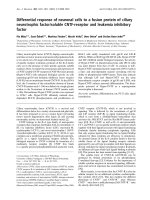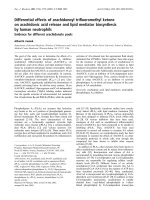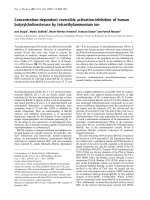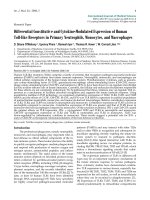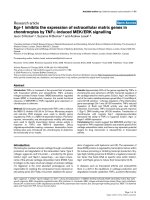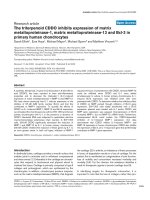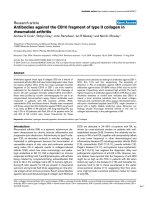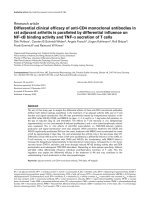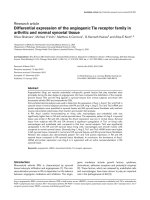Báo cáo y học: "Differential Constitutive and Cytokine-Modulated Expression of Human Toll-like Receptors in Primary Neutrophils, Monocytes, and Macrophages" docx
Bạn đang xem bản rút gọn của tài liệu. Xem và tải ngay bản đầy đủ của tài liệu tại đây (528.56 KB, 8 trang )
Int. J. Med. Sci. 2008, 5
1
International Journal of Medical Sciences
ISSN 1449-1907 www.medsci.org 2008 5(1):1-8
© Ivyspring International Publisher. All rights reserved
Research Paper
Differential Constitutive and Cytokine-Modulated Expression of Human
Toll-like Receptors in Primary Neutrophils, Monocytes, and Macrophages
D. Shane O’Mahony
1
, Uyenvy Pham
1
, Ramesh Iyer
1
, Thomas R. Hawn
1
, W. Conrad Liles
1,2,3
1. Departments of Medicine, University of Washington, Seattle, WA 98195, USA
2. Departments of Pathology, University of Washington, Seattle, WA 98195, USA
3. McLaughlin-Rotman Centre for Global Health, Toronto General Research Institute, University Health Network, and De-
partment of Medicine, University of Toronto, Toronto, ON M5G 2C4, CANADA
Correspondence to: W. Conrad Liles, MD, PhD, Professor and Vice-Chair of Medicine, Director, Division of Infectious Diseases, Toronto
General Hospital, 13E 220, 200 Elizabeth Street, Toronto, ON M5G 2C4, CANADA. Ph: 416-340-4800 x3624; FAX: 416-340-3357;
Email:
Received: 2007.11.14; Accepted: 2008.01.03; Published: 2008.01.04
Human Toll-like receptors (TLRs) comprise a family of proteins that recognizes pathogen-associated molecular
patterns (PAMPs) and initiates host innate immune responses. Neutrophils, monocytes, and macrophages are
critical cellular components of the human innate immune system. Proinflammatory cytokines, such as granulo-
cyte colony-stimulating factor (G-CSF), granulocyte-macrophage colony-stimulating factor (GM-CSF), macro-
phage colony-stimulating factor (M-CSF), and interferon-γ (IFN-γ), have been shown to up-regulate microbicidal
activity in these effector cells of innate immunity. Currently, the cellular and molecular mechanisms responsible
for these effects are not completely understood. We hypothesized that these cytokines may up-regulate TLR ex-
pression as a mechanism to facilitate microbial recognition and augment the innate immune response. Using
quantitative realtime rt-PCR technology, we examined constitutive expression of TLR2, TLR4, TLR5, and TLR9
mRNA and the effects of G-CSF, GM-CSF, M-CSF, and IFN-γ on TLR mRNA expression in purified populations
of normal human neutrophils, monocytes, and monocyte-derived macrophages. Relative constitutive expression
of TLR2, TLR4, and TLR9 was similar in neutrophils and monocytes. Constitutive expression of TLR5 was less in
neutrophils compared to monocytes. Constitutive expression of TLR4 was greater and that of TLR9 lower in
monocyte-derived macrophages compared to monocytes. Of the cytokines examined, IFN-γ and GM-CSF caused
the greatest effects on TLR expression. IFN- γ up-regulated TLR2 and TLR4 in neutrophils and monocytes.
GM-CSF up-regulated expression of TLR2 and TLR4 in neutrophils and TLR2 in monocytes. TLR5 was
down-regulated by inflammatory cytokines in monocytes. These results suggest a potential role for IFN- γ
and/or GM-CSF as therapeutic immunomodulators of the host defense to infection.
Key words: Toll-like receptor, human, phagocytes, cytokines, innate immunity
Introduction
The professional phagocytes, namely neutrophils,
monocytes and macrophages, play important roles in
host defense as critical cellular components of the in-
nate immune system. These leukocytes have the ability
to quickly recognize pathogens, mediate phagocytosis,
and respond with production of reactive oxygen and
nitrogen species, antimicrobial peptides, and inflam-
matory mediators.[1] The rapid action of the innate
immune system depends on microbial product recog-
nition conferred by germline-encoded pattern recog-
nition receptors (PRRs), including CD14, β2-integrins,
C-type lectins, macrophage scavenger receptors, com-
plement receptors, and the recently identified mem-
bers of the mammalian Toll-like receptor (TLRs).[2] To
date, at least 10 human TLRs have been identified
through DNA sequencing.[3-9] TLRs have specificity
for highly conserved pathogen-associated molecular
patterns (PAMPs) and may interact with other TLRs
and/or other PRRs in recognition and subsequent in-
tracellular signaling, thereby enabling the innate im-
mune system to respond to pathogens discrimi-
nately.[10-12] After ligand interaction with TLRs, in-
tracellular signaling occurs via adaptor proteins, in-
cluding MyD88, TIRAP/Mal, TRIF and TRAM, which
induce a downstream signaling cascade that culmi-
nates in nuclear translocation of NF-κB.[13-15]
The expression patterns of TLRs in different cell
types may be an important regulatory mechanism of
the innate immune response to various pathogens.
Flow cytometry studies have demonstrated constitu-
tive TLR expression in various tissues, especially leu-
kocytes.[16-18] TLR1, TLR2, TLR4, TLR5, and TLR6 are
expressed on the cell surface, as well as intracellularly
where they can be recruited to phagolysosomes. [11,
18] Expression of TLR3, TLR7, TLR8, and TLR9 is lo-
calized predominantly to intracellular compartments
Int. J. Med. Sci. 2008, 5
2
where they recognize viral and/or bacterial nucleic
acids.[19-21] Neutrophils constitutively express all
TLRs except TLR3, whereas monocytes appear to lack
expression of TLR3, TLR6, TLR7, and TLR10. [18, 22,
23] TLR3 expression is limited to endosomes of mye-
loid and monocyte-derived dendritic cells (DCs).
Therefore, myeloid DCs are the only identified cell
type which express the entire repertoire of TLRs. On
the other hand, plasmacytoid DCs have more limited
expression patterns. [22, 24] Recently, Peng et al have
shown that regulatory T-cells express TLR8 and that
the TLR8-MyD88 signaling pathway controls suppres-
sive function of Treg cells.[25] These findings suggest
that the unique expression patterns of TLRs in various
tissues are important for their functional biologic role
in immunity.
TLR2, TLR4, TLR5 and TLR9 play critical roles in
innate immune recognition of bacteria (Reviewed in
[15]). TLR1 and TLR6 contribute to discrimination of
bacterial lipopeptides by functionally combining with
TLR2.[26] TLR2 has been associated with recognition
of cell wall structures of gram-positive bacilli, my-
coplasma, mycobacteria and yeast including lipopro-
teins, glycolipids, and zymosan.[27-32] TLR4 is con-
sidered fundamental to detection of LPS from
gram-negative bacteria.[33, 34] Bacterial flagellin has
been shown to be the ligand for TLR5, and TLR9 rec-
ognizes CpG motifs on bacterial DNA.[21, 35, 36] Bac-
terial products and proinflammatory cytokines have
been shown to contribute to the regulation of TLR ex-
pression on monocytes and neutrophils, but the role of
pro-inflammatory cytokines in regulation of TLR ex-
pression remains unclear and discrepant in previous
reports.[16, 17, 22, 37-40]
Pro-inflammatory cytokines, such as granulocyte
colony-stimulating factor (G-CSF), granulo-
cyte-macrophage colony-stimulating factor (GM-CSF),
macrophage colony-stimulating factor (M-CSF), and
interferon-γ (IFN-γ), have been shown to up-regulate
microbicidal activity of neutrophils and/or mono-
cytes/macrophages. All four of these cytokines, which
are available in recombinant human form, have been
proposed and considered as adjunctive immuno-
modulatory agents to treat serious or refractory infec-
tions in humans.[41, 42]
Currently, the precise cellular
and molecular mechanisms responsible for these ef-
fects are not completely understood but may poten-
tially include up-regulation of molecules involved in
pathogen recognition, such as TLRs. Indeed, recent
studies demonstrated that pretreatment of neutrophils
with GM-CSF modulates TLR expression and cytokine
responses to several TLR ligands.[37, 38]
In this study, we systematically investigated the
effects of G-CSF, GM-CSF, M-CSF, and IFN-γ on TLR
mRNA expression in human leukocytes, focusing on
the TLRs involved in bacterial recognition. Monocytes
and neutrophils isolated from normal human blood
were cultured in the absence and presence of these
cytokines, and realtime rt-PCR technology was em-
ployed to quantitatively measure relative transcription
of TLR2, TLR4, TLR5 and TLR9.
Methods
Isolation and culture of cells
Human monocytes and neutrophils were isolated
from EDTA-anticoagulated peripheral venous blood of
normal human volunteers according to a protocol ap-
proved in advance by the Human Subjects Committee
of the University of Washington Investigational Re-
view Board. Monocytes were isolated by negative
immunoselection with RosetteSep Human Monocyte
Enrichment Cocktail as described by the manufacturer
(Stem Cell Technologies, Vancouver, Canada). Neu-
trophils were isolated from EDTA-anticoagulated
blood by sequential sedimentation in dextran (Sigma,
St. Louis, MO) in 0.9% sodium
chloride, centrifugation
over Histopaque-1077 (Sigma), and hypotonic
lysis of
erythrocytes, as previously described.[43] Cells were
cultured in RPMI 1640 (BioWhittaker, Walkersville,
MD) supplemented with 10% heat-inactivated fetal
bovine serum (BioWhittaker), 1% L-glutamine, 1%
HEPES, and 0.5% penicillin-streptomycin (all from
BioWhittaker). Isolated monocytes were used imme-
diately or were incubated at 37˚C in a 5%
CO
2
-controlled incubator for the designated time pe-
riod without stimuli or in the presence of recombinant
human IFN-γ (1000 units/ml) (R&D Systems Min-
neapolis, Minnesota), recombinant human GM-CSF
(100 ng/ml) (Immunex, Seattle, WA), recombinant
human M-CSF (100 ng/ml) (R&D Systems), or LPS (1
μg/ml) (Sigma). Neutrophils were used immediately
or were incubated with recombinant human IFN- γ
(1000 units/ml), recombinant human G-CSF (100
ng/ml) (Amgen, Thousand Oaks, CA), recombinant
human GM-CSF (100 ng/ml), or LPS (1 μg/ml). The
doses of cytokines were chosen based on previous
work in our lab that demonstrated what the doses
yielded maximal activation of human neutrophils and
monocytes/macrophages. [41, 44] Macrophages were
prepared from isolated monocytes by incubation in the
presence of M-CSF (100 ng/ml) for 7 days in Teflon
beakers, as previously described.[45]
Quantitative Real-Time rt-PCR
Total cell RNA was isolated from 5 x 10
6
mono-
cytes or macrophages and 12 x 10
6
neutrophils using
the RNeasy Minikit 50 according to instructions by the
manufacturer (Qiagen, Valencia CA). DNAfree (Am-
bion Inc, Austin, TX) was used to remove contami-
Int. J. Med. Sci. 2008, 5
3
nating DNA. Reverse transcription to prepare cDNA
was performed with random primers (Amersham
Pharmacia Biotech, Piscataway, NJ) and Superscript II
(Life Technologies, Carlsbad, CA). RNAseOUT (Life
Technologies, Carlsbad, CA) was used to inhibit ri-
bonuclease activity during reaction sequences. mRNA
and cDNA samples were quantified by UV spectros-
copy measurements. The PCR reaction volume was 20
μl containing 6 μl cDNA sample, 10 μl 2X Taqman
Universal PCR Master Mix (PE Applied Biosystems,
Foster City, CA), 0.1 μl of each primer (Biosearch
Technologies, Inc., Novato, CA), 0.225 μl fluorogenic
probe (Biosearch Technologies), and 3.575 μl DNAase
free water. The oligonucletoide primers for respective
TLRs were CTGCAAGCTGCGGAAGATAAT, TLR2;
AGAGTTTCCTGCAATGGATCAAG, TLR4;
GGCTTAATCACACCAATGTCACTATAG, TLR5;
and TCTGAAGACTTCAGGCCCAACT, TLR9 for
forward primers, and GCAGCTCTCAGATTTACCC-
AAAA, TLR2; TTATCTGAAGGTGTTGCACATTCC,
TLR4; TTAAGACTTCCTCTTCATCACAACCTT,
TLR5; and TGCACGGTCACCAGGTTGT, TLR9 for
the reverse primers. The fluorogenic probes were
CCGCTGAGCCTCGTCCATGGG, TLR2;
TTCGTTCAACTTCCACCAAGAGCTGCCT, TLR4;
TACACACAATATATGTCTGCAGGAGGCCCA,
TLR5; and AGCACCCTCAACTTCACCTTGGATCT-
GTC, TLR 9. A GeneAmp 5700 Sequence Detection
System (PE Applied Biosystems) was used to complete
the PCR reactions and monitor chain elongation. Rela-
tive expression of TLRs was normalized to expression
of 18s RNA. The final normalized results were calcu-
lated by dividing the relative transcript levels of the
test genes by the relative amount of the 18s RNA.
Statistical analysis
Expression levels are expressed as means +/- SD.
Comparisons between multiple groups were per-
formed by factorial analysis of variance (ANOVA). A p
value < 0.05 was considered significant.
Results
Relative constitutive expression of TLR2, TLR4, TLR5,
and TLR9 in normal human neutrophils, monocytes,
and monocyte-derived macrophages
Constitutive mRNA expression was measured in
monocytes and neutrophils immediately after cell iso-
lation procedures. Expression of TLR2, TLR4, TLR5
and TLR9 was detectable in normal human peripheral
blood monocytes. Neutrophils had similar relative
constitutive expression of TLR2, TLR4 and TLR9, but
less TLR5, compared to monocytes (Figure 1).
Figure 1. Relative constitutive expression of neutrophil TLR2,
TLR4, TLR5, and TLR9 expressed as percentages of monocyte
expression of these TLRs in normal human monocytes and
neutrophils. mRNA was prepared from 5x10
6
monocytes (n=10
independent healthy volunteers) or 12x10
6
neutrophils (n=5
independent healthy volunteers) immediately following isola-
tion of cells. Quantitative real time rt-PCR technology was used
to determine relative expression of TLRs normalized to the
expression of 18s.
Monocytes can be differentiated into macro-
phages in vitro through incubation in the presence of
M-CSF for 7 days.[46] Macrophages that were derived
in vitro constitutively expressed TLR2 and TLR5 at
similar levels compared to monocytes. In contrast,
TLR4 expression was significantly increased by 280 ±
134 %, and TLR9 expression was decreased to barely
detectable levels when compared to monocytes (Figure
2).
Figure 2. Relative constitutive expression of monocyte-derived
macrophage TLR2, TLR4, TLR5, and TLR9 expressed as per-
centages of monocyte expression of these TLRs. mRNA was
prepared from 5x10
6
monocytes (n=10 independent healthy
volunteers) immediately following isolation of cells. Macro-
phages were prepared from monocytes by incubation in the
presence of M-CSF (100ng/ml) for 7 days. mRNA was prepared
from 5x10
6
macrophages (n=6 independent healthy volunteers).
Quantitative real time rt-PCR technology was used to determine
relative expression of TLRs normalized to the expression of 18s.
Repeated measures ANOVA was used for statistical analysis. *
indicate statistical significance with P<0.05.
Int. J. Med. Sci. 2008, 5
4
Modulation of TLR2, TLR4, TLR5, and TLR9 expres-
sion in normal human monocytes by IFN-
γ
, GM-CSF,
and M-CSF
Monocytes were isolated and purified from hu-
man peripheral blood and then incubated in the pres-
ence of stimulatory cytokines. Incubation with IFN-γ
for 3 hours up-regulated expression of TLR2 and TLR4
and down-regulated TLR5 expression in monocytes.
TLR9 expression was not affected by IFN-γ (Figure 3).
Figure 3. Modulation of TLR expression in normal human
monocytes by IFN-γ, GM-CSF, and M-CSF following incuba-
tion for 3-hours. mRNA was prepared from 5x10
6
monocytes
immediately after cell isolation (constitutive expression) or after
a three hour incubation in the presence of IFN-γ (10
3
units/ml),
GM-CSF (100ng/ml), or M-CSF (100ng/ml). n=4 healthy nor-
mal human donors for TLR2 and TLR4. n=3 normal healthy
donors for TLR5 and TLR9. Quantitative real time rt-PCR
technology was used to determine relative expression of TLRs
normalized to the expression of 18s. Repeated measures
ANOVA was used for statistical analysis. * indicate statistical
significance with P<0.05.
Following a 3-hour incubation with GM-CSF,
monocytes had increased expression of TLR2 and de-
creased expression of TLR5. TLR2 was significantly
increased by 740 ± 180 %. TLR4 and TLR9 levels were
not affected by GM-CSF (Figure 3).
Monocyte TLR2 and TLR5 expression was also
affected by a 3-hour incubation with M-CSF. TLR2
expression was up-regulated by 450 ± 100 %. TLR5 was
down-regulated, while expression of TLR4 and TLR9
was not altered (Figure 3).
After a 24-hour incubation, LPS had a robust ef-
fect on the expression of monocyte TLR2, with
upregulation by 450 ± 160%. IFN-γ and GM-CSF did
not maintain increased expression of TLR2 as seen
after the 3-hour incubation, and the levels of expres-
sion had returned to the baseline constitutive expres-
sion of unstimulated monocytes at time zero. M-CSF
caused a trend toward increased TLR2 expression and
maintained TLR5 levels at initial constitutive levels.
IFN-γ, GM-CSF and LPS all led to decreased levels of
TLR5. TLR9 expression was at initial constitutive levels
at 24 hours following incubation with each of the cy-
tokines whereas LPS stimulation resulted in a trend to
reduced levels (Figure 4).
Figure 4. Modulation of TLR expression in normal human
monocytes by IFN-γ, GM-CSF, M-CSF or LPS following in-
cubation for 24-hours expressed as percentages of constitutive
monocyte expression at time zero. mRNA was prepared from
5x10
6
monocytes immediately after cell isolation (constitutive
expression) or following a 24-hour incubation in the absence or
presence of IFN-γ (10
3
units/ml), GM-CSF (100ng/ml), M-CSF
(100ng/ml) or LPS (1μg/ml). n=4 healthy normal human donors
for TLR2 and TLR9. n=5 normal healthy donors for TLR4 and
TLR5. Quantitative real time rt-PCR technology was used to
determine relative expression of TLRs normalized to the ex-
pression of 18s. Repeated measures ANOVA was used for
statistical analysis. * indicate statistical significance with
P<0.05.
Modulation of TLR2, TLR4, TLR5, and TLR9 expres-
sion in normal human neutrophils by IFN-
γ
, GM-CSF,
and G-CSF
Human peripheral blood neutrophils were
evaluated for changes in expression of TLR2, TLR4,
TLR5, and TLR9 following incubation with
pro-inflammatory cytokines. Short term (3-hour) in-
cubation with IFN-γ up-regulated expression of TLR2,
TLR4 and TLR5 in neutrophils by 237 ± 80 %, 307 ± 87
% and 417 ± 130 %, respectively. In contrast, IFN-γ
down-regulated TLR9 expression in neutrophils (Fig-
ure 5).
A 3-hour incubation with G-CSF up-regulated
expression of all four TLRs in neutrophils (Figure 5).
Specifically, G-CSF induced up-regulation of TLR2
expression by 182 ± 44 %, TLR 4 expression by 303 ± 74
%, TLR5 expression by 318 ± 96 %, and TLR9 expres-
sion by 192 ± 92 %.
GM-CSF also strongly up-regulated neutrophil
TLR2 (292 ± 105 %) and TLR4 412 ± 147 %) expression
in neutrophils. TLR9 expression was up-regulated to a
lesser extent. In contrast to IFN-γ and G-CSF, GM-CSF
induced a strong down-regulation in TLR5 expression
after a 3-hour incubation (Figure 5).
Int. J. Med. Sci. 2008, 5
5
Figure 5. Modulation of TLR expression in normal human
neutrophils by IFN-γ, G-CSF, and GM-CSF following incuba-
tion for 3-hours expressed as percentages of constitutive neu-
trophil expression. mRNA was prepared from 12x10
6
neutro-
phils immediately after cell isolation (constitutive expression)
or after a three hour incubation in the presence of IFN-γ (10
3
units/ml), G-CSF (100ng/ml), or GM-CSF (100ng/ml). n=4
healthy normal human donors for TLR2 and TLR4. n=3 normal
healthy donors for TLR5 and TLR9. Quantitative real time
rt-PCR technology was used to determine relative expression of
TLRs normalized to the expression of 18s. Repeated measures
ANOVA was used for statistical analysis. * indicate statistical
significance with P<0.05.
Neutrophil TLR expression patterns were also
measured after a 24-hour incubation. Cytokine stimu-
lated cell preparations were compared to both baseline
(time zero) constitutive expression and unstimulated
cells at 24hours since neutrophils undergo rapid
apoptosis soon after isolation. After a 24-hour incuba-
tion, expression of TLR2 and TLR4 declined in neu-
trophils maintained in culture in the absence of cyto-
kine supplementation. Specifically, TLR2 and TLR4
expression decreased by 76 ± 9.5 % and 78 ± 10 %, re-
spectively. Incubation with G-CSF, GM-CSF, or LPS
did not affect the decline in TLR4 expression. In con-
trast, TLR4 expression was maintained at baseline
constitutive levels after incubation with IFN-γ. TLR2
expression was maintained at initial constitutive levels
when neutrophils were incubated for 24 hours in the
presence of IFN-γ, G-CSF or GM-CSF. LPS increased
TLR2 expression above the initial constitutive expres-
sion level by 390 ± 170 % (Figure 6).
Figure 6. Modulation of TLR expression in normal human
neutrophils by IFN-γ, G-CSF, GM-CSF or LPS following in-
cubation for 24-hours expressed as percentages of constitutive
neutrophil expression. mRNA was prepared from 12x10
6
neu-
trophils immediately after cell isolation or following a 24-hour
incubation in the absence or presence of IFN-γ (10
3
units/ml),
G-CSF (100ng/ml), GM-CSF (100ng/ml) or LPS (1μg/ml). n=3
healthy normal human donors for TLR2 and TLR4. Quantitative
real time rt-PCR technology was used to determine relative
expression of TLRs normalized to the expression of 18s. Re-
peated measures ANOVA was used for statistical analysis. *
indicate statistical significance with P<0.05.
Discussion
Previous studies have shown that human TLRs
are differentially expressed in a variety of tissues.[16,
17, 22, 23] This study examined the expression of
TLR2, TLR4, TLR5, and TLR9 in normal primary hu-
man professional phagocytes. Constitutive expression
of TLR2, TLR4, and TLR9 was found to be similar in
monocytes and neutrophils, while neutrophils ex-
pressed relatively less TLR5 compared to monocytes.
Normal human monocyte-derived macrophages had
similar expression levels of TLR2 and TLR5 when
compared to monocytes. In contrast, relative TLR4
expression was increased in macrophages, and TLR9
expression could not be detected in macrophages. Al-
though previous studies have reported expression of
these TLRs in human neutrophils, monocytes, and/or
macrophages, the present study is the first to describe
and directly compare relative expression levels in all 3
primary cell types.[22, 23, 37, 38]
Various stimuli have been shown to regulate ex-
pression of TLRs in leukocytes, including pathogen
structures and TLR ligands, such as araLAM and LPS,
and pro-inflammatory cytokines, including IL-1β,
TNF-α, GM-CSF and IFN-γ.[16, 22, 37, 38] It is plausi-
ble that an advantage in pathogen recognition is con-
ferred by controlled expression of germline-encoded
pathogen recognition receptors by pro-inflammatory
signaling. Recent studies revealed that expression of
both TLR2 and TLR4 is increased in monocytes and
neutrophils from human patients with sepsis. [47, 48]
In these studies, ligands for either TLR2 or TLR4 failed
to directly affect expression of TLR2 or TLR4 in
monocytes and neutrophils from either septic patients
or controls, suggesting the possibility that increased
expression of TLRs in this setting may be mediated via
by pro-inflammatory cytokines rather than TLR-ligand
binding per se.
The results of our study demonstrate that several
pro-inflammatory cytokines contribute to the regula-
tion of TLR expression. Of the cytokines studied, IFN-γ
and GM-CSF caused the most robust effects on TLR
expression with statistically significantly increased
Int. J. Med. Sci. 2008, 5
6
TLR2 expression in monocytes, a trend for increased
TLR4 in monocytes (IFN-γ) and trends for increased
TLR2 and TLR4 in neutrophils. These cytokines have
been shown to increase the microbicidal activity of
monocytes and neutrophils. [42] We hypothesize that
the effects on TLR expression by these cytokines con-
tribute to the enhanced antimicrobial activity. Our
study cannot evaluate this directly but previous pub-
lications support the premise that increased TLR ex-
pression enhances the effector cell response to TLR
ligands.
Several studies have identified an association
between increased inflammatory activity in monocytes
and neutrophils after TLR expression modulation by
IFN-γ or GM-CSF. IFN-γ-primed monocytes had in-
creased TLR4 expression and also increased responses
to LPS, as measured by NF-κB DNA binding activity
and cytokine production (e.g., TNF-α).[39] Neutrophils
had increased protein and mRNA expression of TLR2
and TLR9 after incubation with GM-CSF.[38] Fur-
thermore, neutrophils pre-incubated with GM-CSF
had increased inflammatory activity, as measured by
IL-8 production due to signaling through various TLR
ligands.[38] In another study, GM-CSF increased
TLR2-mediated cytokine and superoxide anion pro-
duction in neutrophils.[37] In vivo models have also
demonstrated an association between TLR expression
levels controlled by proinflammatory cytokines and
increased responses to TLR ligands. GM-CSF was
shown to play an important role in inflammatory sig-
naling in a model of LPS-induced lung injury. Pre-
treatment of mice with an inhibitor of GM-CSF prior to
LPS instillation caused decreased TLR4 mRNA ex-
pression, associated with decreased lung neutrophil
and macrophage infiltration and decreased levels of
TNF- α and macrophage inflammatory protein-2
(MIP2). [49] In another study using transgenic mice
with varyingTLR4 DNA copy number, mice with in-
creased TLR4 DNA copies had increased lung in-
flammatory responses to intranasally administered
LPS. [50]
While TLR2 and TLR4 were up-regulated by
GM-CSF and IFN-γ in monocytes, TLR5 expression
was diminished by these cytokines in monocytes and
by GM-CSF in neutrophils. These results may high-
light the relative importance of TLR2 and TLR4 in
anti-bacterial innate immunity surveillance. Alterna-
tively, they suggest that separate expression control of
TLR5 by inflammatory cytokines may contribute to
regulation of innate immunity in monocytes and neu-
trophils.
The effects of G-CSF and M-CSF on TLR expres-
sion in neutrophils and monocytes were less striking.
Neutrophil surface TLR2 has been shown to be in-
creased by G-CSF in previous studies.[37] The present
study demonstrated a small increase in expression of
TLR2 mRNA in neutrophils. Unlike IFN-γ and
GM-CSF, only G-CSF led to increased levels of both
TLR5 and TLR9 in neutrophils.
This study did not evaluate the effects of im-
mune-modulating cytokines on protein expression but
focused on the effects on TLR mRNA expression. Pro-
inflammatory cytokines may also control protein ex-
pression of TLRs on the cell surface and intracellularly
through regulation of inhibitory RNA pathways, pro-
tein translation and post-translational processes. Our
results show that TLR mRNA expression is regulated
by these cytokines, and we speculate that this may
contribute to enhanced cellular responses to patho-
gens.
The human TLR family is a recently described
component of the human innate immune system, and
our knowledge of the regulation of these patho-
gen-discriminating receptors continues to evolve. This
report demonstrates that cytokines with known ability
to enhance microbicidal activity of phagocytes differ-
entially regulate TLR2, TLR4, TLR5 and TLR9 mRNA
expression in neutrophils and monocytes. IFN-γ
strongly increased the expression of the bacterial rec-
ognition receptors TLR2 and TLR4 on both neutrophils
and monocytes. GM-CSF treatment also increased ex-
pression of TLR2 and TLR4 on neutrophils and has
previously been shown to enhance TLR ligand re-
sponses by these cells. These results demonstrate that
up-regulated TLR expression may be a component of
cytokine-mediated enhancement of phago-
cyte-mediated host defense and suggest a promising
role for IFN-γ and/or GM-CSF as therapeutic immu-
nomodulators for enhancing bacterial recognition by
the innate immune system.
Acknowledgements
This study was supported in part by a Magnuson
Scholar Fellowship from the University of Washington
(DSO), RO1 HL62995 from the National Institutes of
Health (WCL), and a Canada Research Chair in Infec-
tious Diseases and Inflammation (WCL).
Conflict of interest
The authors have declared that no conflict of in-
terest exists.
References
1. Medzhitov R, Janeway C Jr. Innate immunity. N Engl J Med
2000; 343(5): 338-44.
2. Medzhitov R, Janeway C Jr. The Toll receptor family and micro-
bial recognition. Trends Microbiol 2000; 8(10): 452-6.
3. Roach JC, Glusman G, Rowen L, et al. The evolution of verte-
brate Toll-like receptors. Proc Natl Acad Sci U S A 2005; 102(27):
9577-82.
4. Chuang T, Ulevitch RJ. Identification of hTLR10: a novel human
Int. J. Med. Sci. 2008, 5
7
Toll-like receptor preferentially expressed in immune cells.
Biochim Biophys Acta 2001; 1518(1-2): 157-61.
5. Chuang TH, Ulevitch RJ. Cloning and characterization of a
sub-family of human toll-like receptors: hTLR7, hTLR8 and
hTLR9. Eur Cytokine Netw 2000; 11(3): 372-8.
6. Chaudhary PM, Ferguson C, Nguyen V, et al. Cloning and char-
acterization of two Toll/Interleukin-1 receptor-like genes TIL3
and TIL4: evidence for a multi-gene receptor family in humans.
Blood 1998; 91(11): 4020-7.
7. Du X, Poltorak A, Wei Y, Beutler B. Three novel mammalian
toll-like receptors: gene structure, expression, and evolution. Eur
Cytokine Netw 2000; 11(3): 362-71.
8. Takeuchi O, Kawai T, Sanjo H, et al. TLR6: A novel member of
an expanding toll-like receptor family. Gene 1999; 231(1-2):
59-65.
9. Rock FL, Hardiman G, Timans JC, Kastelein RA, Bazan JF. A
family of human receptors structurally related to Drosophila
Toll. Proc Natl Acad Sci U S A 1998; 95(2): 588-93.
10. Ozinsky A, Underhill DM, Fontenot JD, et al. The repertoire for
pattern recognition of pathogens by the innate immune system
is defined by cooperation between toll-like receptors. Proc Natl
Acad Sci U S A 2000; 97(25): 13766-71.
11. Underhill DM, Ozinsky A, Hajjar AM, et al. The Toll-like receptor
2 is recruited to macrophage phagosomes and discriminates
between pathogens. Nature 1999; 401(6755): 811-5.
12. Mukhopadhyay S, Herre J, Brown GD, Gordon S. The potential
for Toll-like receptors to collaborate with other innate immune
receptors. Immunology 2004; 112(4): 521-30.
13. Medzhitov R, Janeway C Jr. Innate immune recognition: mecha-
nisms and pathways. Immunol Rev 2000; 173: 89-97.
14. Belvin MP, Anderson KV. A conserved signaling pathway: the
Drosophila toll-dorsal pathway. Annu Rev Cell Dev Biol 1996;
12: 393-416.
15. Akira S, Takeda K. Toll-like receptor signalling. Nat Rev Immu-
nol 2004; 4(7): 499-511.
16. Flo TH, Halaas O, Torp S, et al. Differential expression of Toll-like
receptor 2 in human cells. J Leukoc Biol 2001; 69(3): 474-81.
17. Zarember KA, Godowski PJ. Tissue expression of human
Toll-like receptors and differential regulation of Toll-like recep-
tor mRNAs in leukocytes in response to microbes, their prod-
ucts, and cytokines. J Immunol 2002; 168(2): 554-61.
18. Parker LC, Whyte MK, Dower SK, Sabroe I. The expression and
roles of Toll-like receptors in the biology of the human neutro-
phil. J Leukoc Biol 2005; 77(6): 886-92.
19. Heil F, Ahmad-Nejad P, Hemmi H, et al. The Toll-like receptor 7
(TLR7)-specific stimulus loxoribine uncovers a strong relation-
ship within the TLR7, 8 and 9 subfamily. Eur J Immunol 2003;
33(11): 2987-97.
20. Matsumoto M, Funami K, Tanabe M, et al. Subcellular localiza-
tion of Toll-like receptor 3 in human dendritic cells. J Immunol
2003; 171(6): 3154-62.
21. Ahmad-Nejad P, Hacker H, Rutz M, Bauer S, Vabulas RM,
Wagner H. Bacterial CpG-DNA and lipopolysaccharides activate
Toll-like receptors at distinct cellular compartments. Eur J
Immunol 2002; 32(7): 1958-68.
22. Muzio M, Bosisio D, Polentarutti N, et al. Differential expression
and regulation of toll-like receptors (TLR) in human leukocytes:
selective expression of TLR3 in dendritic cells. J Immunol 2000;
164(11): 5998-6004.
23. Kokkinopoulos I, Jordan WJ, Ritter MA. Toll-like receptor mRNA
expression patterns in human dendritic cells and monocytes.
Mol Immunol 2005; 42(8): 957-68.
24. Seya T, Funami K, Taniguchi M, Matsumoto M. Antibodies
against human Toll-like receptors (TLRs): TLR distribution and
localization in human dendritic cells. J Endotoxin Res 2005;
11(6): 369-74.
25. Peng G, Guo Z, Kiniwa Y, et al. Toll-like receptor 8-mediated
reversal of CD4+ regulatory T cell function. Science 2005;
309(5739): 1380-4.
26. Hajjar AM, O'Mahony DS, Ozinsky A, et al. Cutting edge: func-
tional interactions between toll-like receptor (TLR) 2 and TLR1
or TLR6 in response to phenol-soluble modulin. J Immunol 2001;
166(1): 15-9.
27. Yoshimura A, Lien E, Ingalls RR, Tuomanen E, Dziarski R, Go-
lenbock D. Cutting edge: recognition of Gram-positive bacterial
cell wall components by the innate immune system occurs via
Toll-like receptor 2. J Immunol 1999; 163(1): 1-5.
28. Takeuchi O, Hoshino K, Kawai T, et al. Differential roles of TLR2
and TLR4 in recognition of gram-negative and gram-positive
bacterial cell wall components. Immunity 1999; 11(4): 443-51.
29. Aliprantis AO, Yang RB, Mark MR, et al. Cell activation and
apoptosis by bacterial lipoproteins through toll-like receptor-2.
Science 1999; 285(5428): 736-9.
30. Underhill DM, Ozinsky A, Smith KD, Aderem A. Toll-like re-
ceptor-2 mediates mycobacteria-induced proinflammatory sig-
naling in macrophages. Proc Natl Acad Sci U S A 1999; 96(25):
14459-63.
31. Lien E, Sellati TJ, Yoshimura A, et al. Toll-like receptor 2 func-
tions as a pattern recognition receptor for diverse bacterial
products. J Biol Chem 1999; 274(47): 33419-25.
32. Schwandner R, Dziarski R, Wesche H, Rothe M, Kirschning CJ.
Peptidoglycan- and lipoteichoic acid-induced cell activation is
mediated by toll-like receptor 2. J Biol Chem 1999; 274(25):
17406-9.
33. Poltorak A, He X, Smirnova I, et al. Defective LPS signaling in
C3H/HeJ and C57BL/10ScCr mice: mutations in Tlr4 gene.
Science 1998; 282(5396): 2085-8.
34.
Hoshino K, Takeuchi O, Kawai T, et al. Cutting edge: Toll-like
receptor 4 (TLR4)-deficient mice are hyporesponsive to
lipopolysaccharide: evidence for TLR4 as the Lps gene product. J
Immunol 1999; 162(7): 3749-52.
35. Bauer S, Kirschning CJ, Hacker H, et al. Human TLR9 confers
responsiveness to bacterial DNA via species-specific CpG motif
recognition. Proc Natl Acad Sci U S A 2001; 98(16): 9237-42.
36. Hayashi F, Smith KD, Ozinsky A, et al. The innate immune re-
sponse to bacterial flagellin is mediated by Toll-like receptor 5.
Nature 2001; 410(6832): 1099-103.
37. Kurt-Jones EA, Mandell L, Whitney C, et al. Role of toll-like
receptor 2 (TLR2) in neutrophil activation: GM-CSF enhances
TLR2 expression and TLR2-mediated interleukin 8 responses in
neutrophils. Blood 2002; 100(5): 1860-8.
38. Hayashi F, Means TK, Luster AD. Toll-like receptors stimulate
human neutrophil function. Blood 2003; 102(7): 2660-9.
39. Bosisio D, Polentarutti N, Sironi M, et al. Stimulation of toll-like
receptor 4 expression in human mononuclear phagocytes by in-
terferon-gamma: a molecular basis for priming and synergism
with bacterial lipopolysaccharide. Blood 2002; 99(9): 3427-31.
40. Mita Y, Dobashi K, Shimizu Y, Nakazawa T, Mori M. Toll-like
receptor 2 and 4 surface expressions on human monocytes are
modulated by interferon-gamma and macrophage col-
ony-stimulating factor. Immunol Lett 2001; 78(2): 97-101.
41. Liles WC. Immunomodulatory approaches to augment phago-
cyte-mediated host defense for treatment of infectious diseases.
Semin Respir Infect 2001; 16(1): 11-7.
42. Hubel K, Dale DC, Liles WC. Therapeutic use of cytokines to
modulate phagocyte function for the treatment of infectious
diseases: current status of granulocyte colony-stimulating factor,
granulocyte-macrophage colony-stimulating factor, macrophage
colony-stimulating factor, and interferon-gamma. J Infect Dis
2002; 185(10): 1490-501.
43. Klebanoff SJ, Olszowski S, Van Voorhis WC, Ledbetter JA, Wal-
tersdorph AM, Schlechte KG. Effects of gamma-interferon on
human neutrophils: protection from deterioration on storage.
Blood 1992; 80(1): 225-34.
Int. J. Med. Sci. 2008, 5
8
44. Gaviria J, van Burik J, Dale D, Root R, Liles W. Comparison of
interferon-gamma, granulocyte colony-stimulating factor, and
granulocyte-macrophage colony-stimulating factor for priming
leukocyte-mediated hyphal damage of opportunistic fungal
pathogens. J Infect Dis 1999; 179(4): 1038-41.
45. Kiener PA, Davis PM, Starling GC, et al. Differential induction of
apoptosis by Fas-Fas ligand interactions in human monocytes
and macrophages. J Exp Med 1997; 185(8): 1511-6.
46. Young DA, Lowe LD, Clark SC. Comparison of the effects of IL-3,
granulocyte-macrophage colony-stimulating factor, and
macrophage colony-stimulating factor in supporting monocyte
differentiation in culture. Analysis of macrophage anti-
body-dependent cellular cytotoxicity. J Immunol 1990; 145(2):
607-15.
47. Armstrong L, Medford AR, Hunter KJ, Uppington KM, Millar
AB. Differential expression of Toll-like receptor (TLR)-2 and
TLR-4 on monocytes in human sepsis. Clin Exp Immunol 2004;
136(2): 312-9.
48. Harter L, Mica L, Stocker R, Trentz O, Keel M. Increased expres-
sion of toll-like receptor-2 and -4 on leukocytes from patients
with sepsis. Shock 2004; 22(5): 403-9.
49. Bozinovski S, Jones J, Beavitt SJ, Cook AD, Hamilton JA, Ander-
son GP. Innate immune responses to LPS in mouse lung are
suppressed and reversed by neutralization of GM-CSF via re-
pression of TLR-4. Am J Physiol Lung Cell Mol Physiol 2004;
286(4): L877-85.
50. Togbe D, Schnyder-Candrian S, Schnyder B, et al. TLR4 gene
dosage contributes to endotoxin-induced acute respiratory in-
flammation. J Leukoc Biol 2006; 80(3): 451-7.
